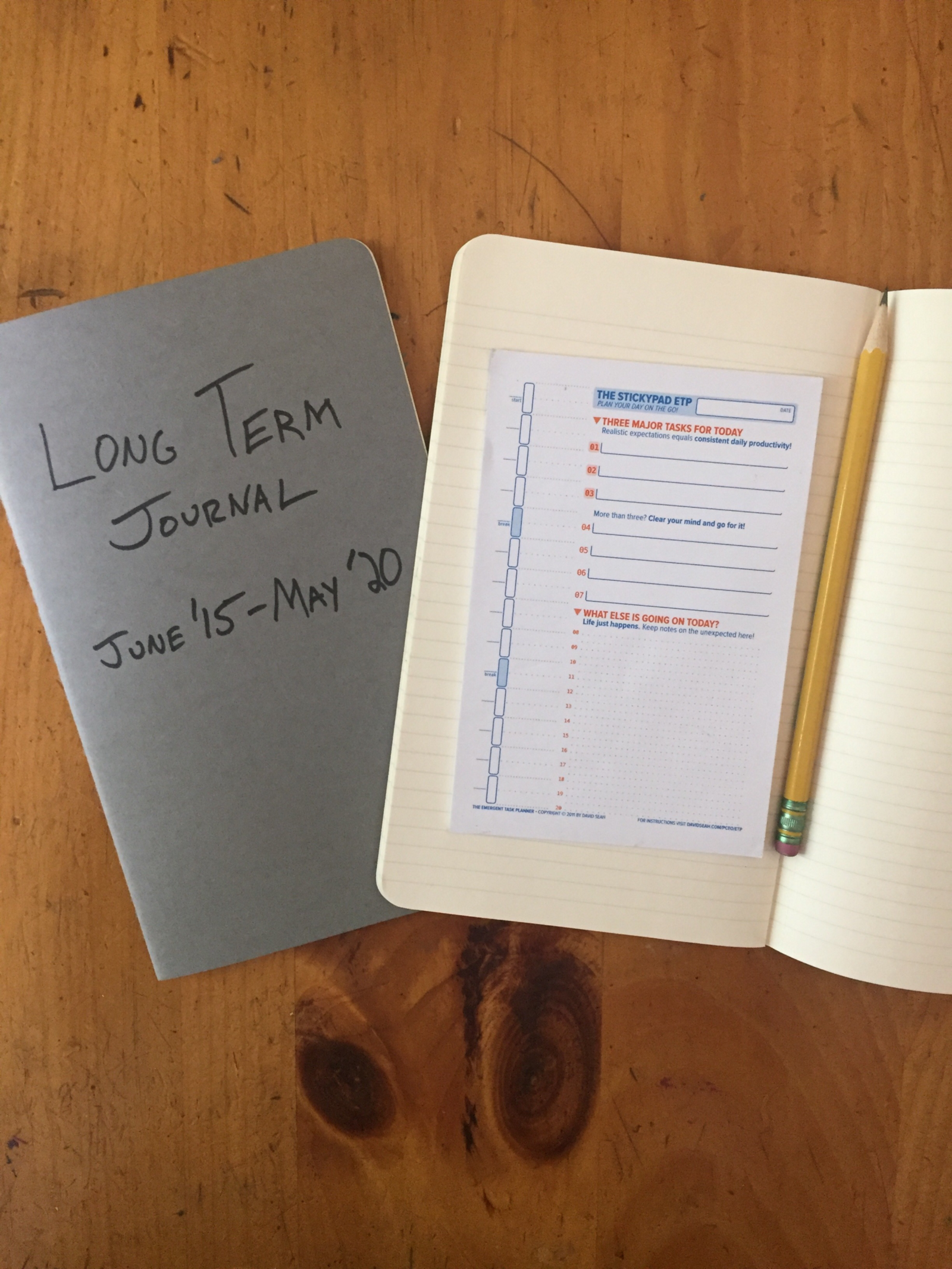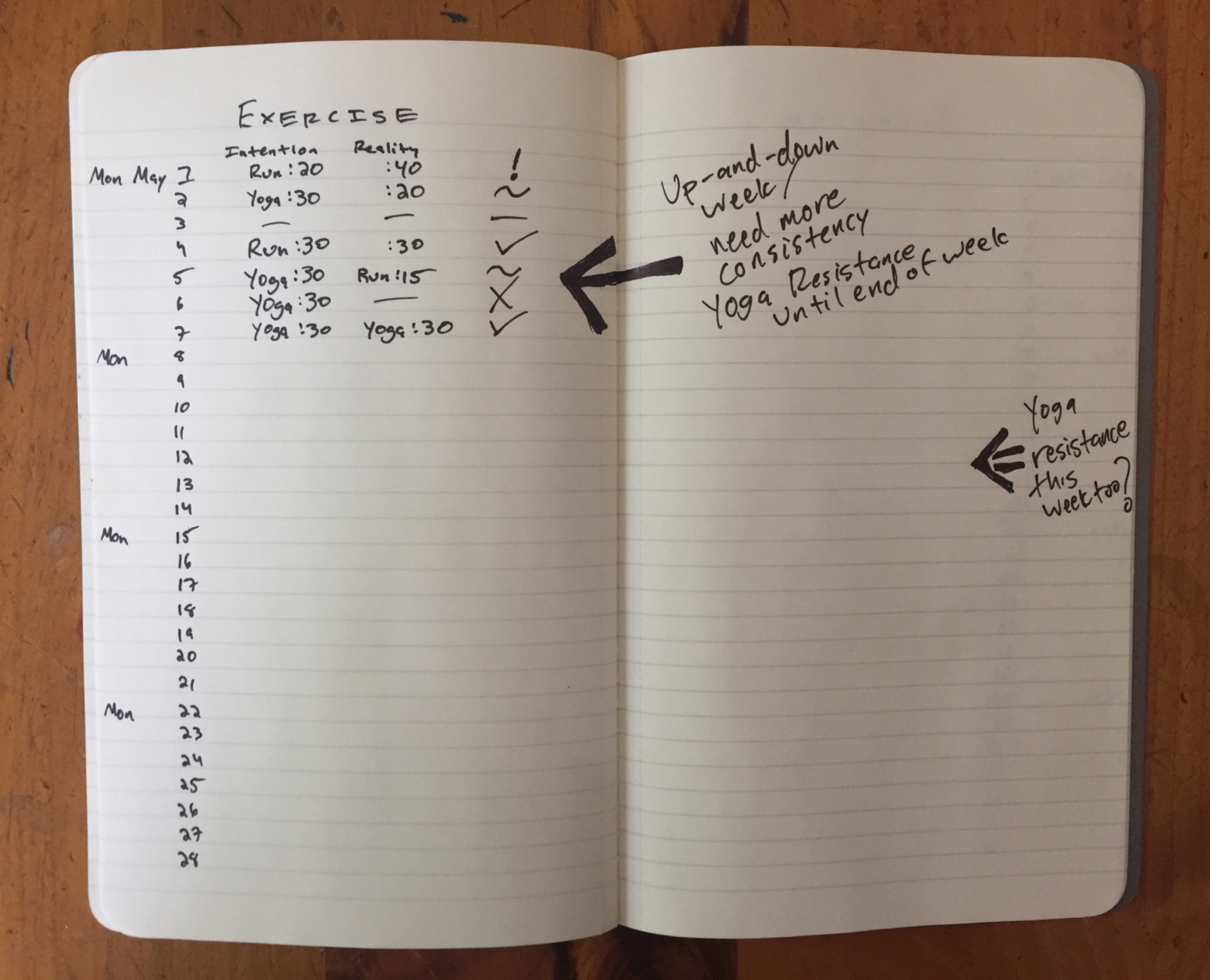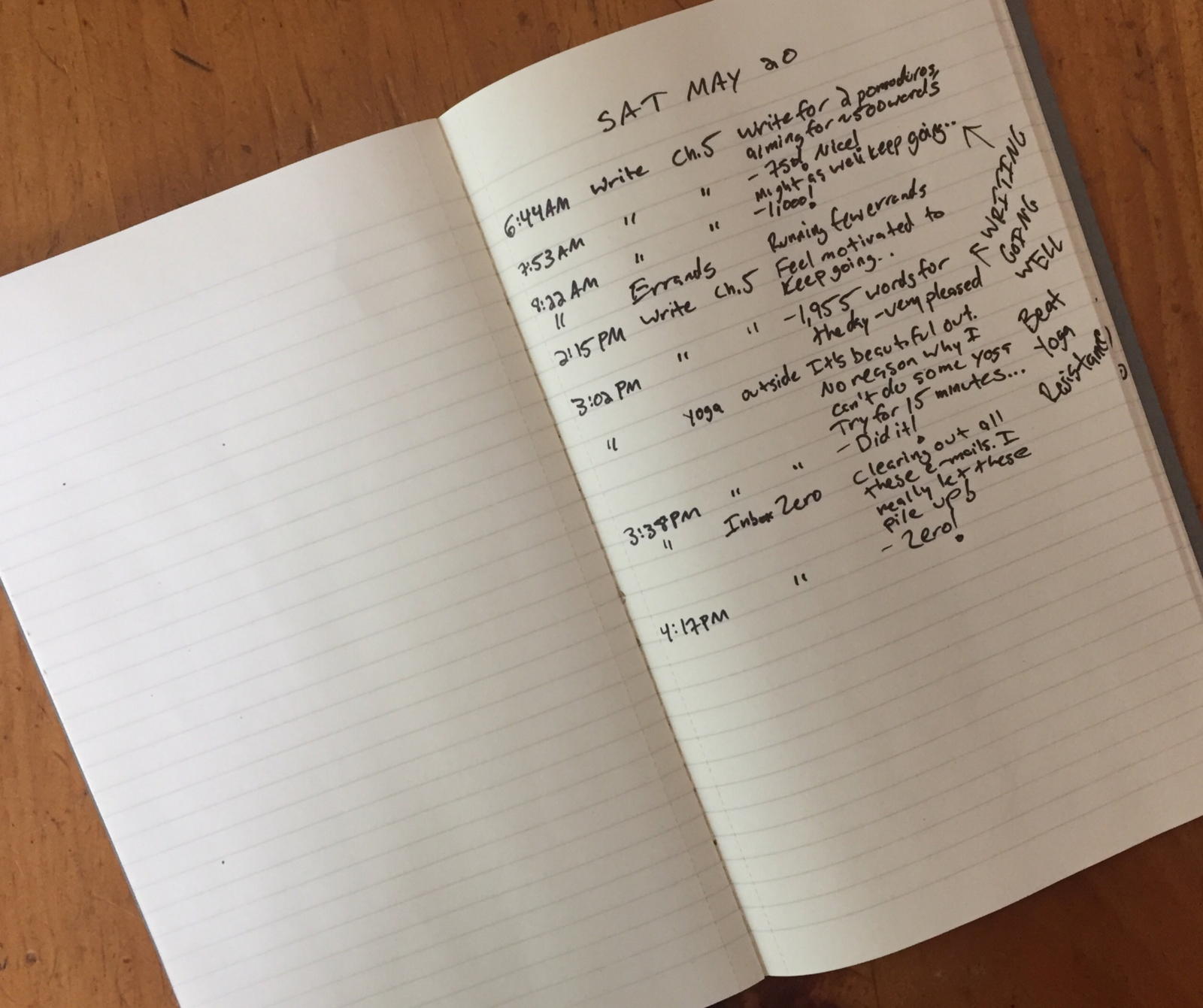How I Use Journaling to Align my Long Term Goals and Short Term Actions
(Warning: This is probably the longest article I've posted here but it received a decent amount of attention on Medium so I thought I would share here too.)
I pursue my long term goals using a set of what I call “productivity journals.” (As featured in my book, Long Term Person, Short Term World.)
Productivity journals are of two types: short term journals (STJs) and long term journals (LTJs.) STJs are maintained on a monthly basis. LTJs are maintained for 5 years.
These periods of time are long enough to get you outside of a short term frame of mind, and short enough to make reasonably reliable long term decisions. (These time-frames can easily be customized. The important part is that one journal is long term and the other is shorter term.)
The LTJ serves as your “base” and is revisited regularly to ensure your short term is aligned with your long term principles and goals.
The STJ is used day-to-day to devise your weekly and monthly plans of attack and to track your short term progress. By recording your progress along the way, you will be able to make calculated adjustments, allowing yourself to more effectively pursue your long term goals.
Together the LTJ and STJ are a powerful, synergistic combination: LTJs allow for a top-down approach to goal achievement. STJs are bottom-up, providing an “on-the-ground” perspective that a top-down approach cannot see, and allowing for the flexibility that a top-down approach cannot foresee.
If you design your STJ based on your LTJ, and if our LTJ evolves based on the STJ, then the journals serve as a two-way bridge between our short and long term selves.
Purpose
I created this system for two reasons:
- I struggled with task, time, and goal management. Waves of productivity followed by still puddle water, again and again.
- I had a bad habit of switching from one flavor-of-the-month system to another before switching again — the grass is indeed always greener. I spent far too much time getting ready to get things done instead ofactually getting things done.
The system addresses these two problems by allowing me to:
- Manage my tasks, time, and goals on a consistent, long term, and realisticbasis.
- Be both creative and analytical in my pursuit of productivity. If it’s easy, flexible, and (sorta) fun, it won’t produce friction — I’ll use it, reliably.
And I do.
What differentiates this from other systems?
There are two important differences between this system and other journal-based productivity systems.
- Tasks unrelated to your most important goals are nowhere near these journals. Productivity journals are sacred. In them, you will uncover amazing, actionable truths about yourself — this won’t happen if “buy toilet paper” is a few lines up.
- Daily, (relatively) freeform journaling is a critical component of STJs — in fact, most of the pages are dedicated to this habit. It is the cornerstone habit upon which your productivity — task, time, and goal management — is built.
What’s so great about journaling?
Journaling, whether by the method described here or otherwise, has enormous benefits. Equally important, journaling is easy, which means it’s an easy habit to start and stick with. You literally just move your hand around a page or type into your computer. It almost doesn’t even matter what you write or type — it’s just the act that matters.
Perhaps the greatest benefit is journaling ability to help us understand ourmental models and improve our emotional intelligence (EI).The interference of mental models and low EI are the greatest impediments to personal productivity and sound goal management.
Mental models are subconscious thoughts and beliefs that inform how we view the world and how we choose to act within it. They’re invisible, silent angels and devils on our shoulders.
Journaling is among the best ways to examine ourselves on a deeper level and discern the models by which we live.
Emotional intelligence is our ability to recognize emotion in ourselves and others, and use this information effectively.
In walks journaling. By recording events and thoughts, we can learn how to improve both self- and social awareness, and we can better manage our behavior.
In short, journaling makes us more effective and more authentic versions of ourselves.
Tools
When setting up this system, the gatekeeper decision is whether to go digital with a word processor or journal app, or analog with paper and pencil. Both would work fine. Here, I describe my preference (analog), but all of this applies equally.
I use Moleskine’s large Cahier journals for both my monthly STJ and my 5-year LTJ:
They’re cheap (about $3 each.) They have exactly 80 pages which is perfect for my purposes. It is just about the most pages I’d ever need for an STJ and short enough that I am not tempted to overwrite and overanalyze in the LTJ.
Perfect for succinct writing in the LTJ and detailed, comprehensive writing in the STJ.
So, yeah, I’m a big fan of these journals. But there are plenty of other journals and notebooks that work just as well — longer, shorter, hardcover, blank, gridded, etc., etc.
My journals do not travel far without two things:
A key component of my system are David Seah’s Emergent Task Planner stickypads.
And a pencil. Specifically, this pencil, because no other pencil should exist.
Setup
Below, I describe my STJ and LTJ setup. This will give you a decent idea about how to set up your own. If you are interested in more detailed explanations, you can check out my book or website, sign-up for a free e-mail course, or Tweet/DM me @mjmottajr.
I organize both journals so they function front — to — back for one purpose and back — to — front for another. This prevents needless flipping-through to find the right page.
Setting Up Long Term Journal
Inside Cover: The inside cover of the LTJ serves two purposes. The top-half describes a few principles that guide my choice of goals and motivate my actions. I won’t spend time walking you through how you determine your life’s principles — but if you distill your goals down to their core, I think you’re off to a good start. (I recommend this book for that purpose.)
The bottom-half lists the goals that have been achieved since the LTJ was created. (Make sure to leave enough room here — you’ll be surprised what you can accomplish once you put your aspirations to paper.)
Monthly Pages: Working front-to-back, the first 60 pages of the LTJ are reserved for the 60 months in the next 5 years of your life. (It’s scary, but also exciting.)
Each monthly page has three sections: The first few lines describe the guideposts for the month, preferably written after reviewing the previous month.
The middle-third of each monthly page is for a review, written at the end of the month. How did it go? Where did I succeed and fail? What affected my results? (Here, pay particular attention to your resources.)
The bottom-third is for adjustments and thoughts for the following month. What did I learn? What should I modify going forward? (Here, too, think of your resources, and how they can be better allocated.)
Goal Pages: The next 20 pages are for selected goals. By “selected,” I mean goals that I have chosen to be part of my day-to-day now, or in the near future, not those I’m planning on doing sometime amorphous down the road. (I put these on post-its I keep in the LTJ until they’re ready for their own page. Also, not every goal in your queue gets promoted — some become less important as time goes on.)
Working back to front, I give selected goals a page. On the first few lines, I give the goal a name and describe it using the SMARTEST method . Then, on the lines below, indented and double-spaced, are short descriptions of the most important actions necessary for achieving the goal and associated guideposts. (Not all goals use up the whole page, but I like to give each a fresh page.)
Setting Up Short Term Journal
Daily Journaling: The first 60 pages are dedicated to daily journaling, although pages do not correspond to particular days as you may write more or less on any given day.
My journal has a few guidelines but no hard-and-fast rules. (Remember: Structured yet flexible.)
I skip lines between entries, date- and time-stamp them, and try to write for more than a page. Sometimes I go over, sometimes I manage only a few lines.
Most entries begin with a recitation of something that happened or something that’s coming up. Sometimes it’s something that is heavy on my mind, other times it’s “I just woke up. The coffee is good.”
More often than I’d like to admit, those are the most intelligible sentences I write.
But I know that far more important than intelligibility, is keeping the habit, even if I just write “Today was good” or “I’m writing this to keep the habit” (which I wrote on June 10, 2016, because I was both busy and uninspired.)
I have themes based on the day of the week, but they primarily serve as a back-up if I can’t think of anything to write day-of. (You can read about my themes here .)
Latter Pages: The latter 20 pages of my STJ serve the following purposes (listed in order back — to — front):
• Monthly guideposts (“mini” goals, described in greater detail in my book, drawn from the LTJ at the beginning of every month) (1 pg.)
• Weekly guideposts (informed by the monthly guideposts.) The bottom lines are for results and adjustments going forward.
• Dedicated pages for goals and practices
I use 2 pages for each of the following: tasks in pursuit of long term goals, and important habits I try to maintain such as exercise and meditation. Here, I’m tracking my overall progress and assessing the correlation between my intentions (“Run 2 miles”) and the actual reality (“Ran 1 mile.”)
By comparing intentions to realities, and by investigating the context, you unite two versions of yourself: the person you thought you would be and the person you actually were. When they meet, a lot can be learned.
Down the left side of the left page is the day or date followed by the intention and the reality. On the right page are comments and thoughts regarding the “meeting of minds” between the two versions of ourself.
As you can see below, I keep things simple, preferring a simple tracking system rather than an elaborate spreadsheet or such. Here’s how I keep track:
- a checkmark if I met my intention;
- an exclamation point if I exceeded it;
- a tilde if I did something, but not to the extent intended;
- an ugly X if I did nothing; or
- a dash if there was no intention (e.g., the weekend or family plans.)
Daily Logs
Continuing to move back-to-front is a section for logging throughout the day. I have found this very effective in keeping me on track, making sure I stay “ pareto ” and giving me insights as to how to up my game. I am not super-strict about it, but I try to:
- date the top of a page;
- write down the current time on the left;
- in the next column, the general project I am about to begin working on
- in the next, a short description of what specifically I intend on doing (“edit ch. 2”);
- progress notes
The far right column I reserve for short insights and notes that will help me during my weekly or monthly review.
This serves at least five functions:
Accountability: “10:24 AM — Feel tired but gonna try” takes less than ten seconds to write, but for whatever reason, it holds your feet to the fire.
Breadcrumbs: If you are anything like me, you will not remember where you left off unless the notes are detailed.
Timing: Humans are notoriously bad at estimating how long a task will take. The proof, as always, is in the pudding.
Reviewing: A log is a great reminder of how your day-to-day went. There is much insight to be gleaned from these records, insight that would be otherwise unavailable.
Transitioning: A log is also very helpful when one month (and STJ) has ended, and another is about to begin. You can see where you left off on each particular project, and transfer the information over all at once.
To-do lists
The beauty of the Emergent Task Planner (or ETP) is that it allows you to make a to-do list (on the right side) and plan out when you’re going to knock out those tasks (on the left side.) And, because this forces you to consider how long a particular task will take, you’ll be able to swap things around if need be.
The beauty of the stickypad version of the ETP is that you can stick the list right in your journal. I like to put it across from my log for ease of reference.
Long and the Short of It
You do not need to wait for the new year or the beginning of a new month to begin a project such as this. There is nothing magical about either of these events. You have as much right to define periods of time as society does, or even as the moon does.
Begin today or tomorrow if you can; pick another day if you must.
What better time than now? What better place than here?
Again, I highly recommend Moleskine’s large Cahier journals for both your LTJ and STJs, as well as the Emergent Task Planner stickypads. (Oh, and this pencil, of course.)
There are near-infinite combinations of tools that can make productivity journals. Find what works for you.
This is partly excerpted from Long Term Person, Short Term World.












